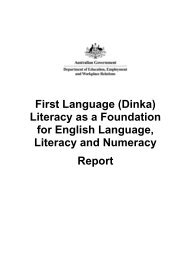Review - Department of Innovation, Industry, Science and Research
Review - Department of Innovation, Industry, Science and Research
Review - Department of Innovation, Industry, Science and Research
You also want an ePaper? Increase the reach of your titles
YUMPU automatically turns print PDFs into web optimized ePapers that Google loves.
The Regulatory monitoring <strong>and</strong> reporting booklet (2007) addresses monitoring the performance <strong>of</strong><br />
awarding bodies <strong>and</strong> evaluating their qualifications. The approach noted is that greater emphasis is put<br />
on the awarding bodies’ quality assurance arrangements, <strong>and</strong> the regulatory authority monitoring <strong>and</strong><br />
evaluating activities will be based on a risk assessment. Risk criteria are noted as:<br />
a) the extent <strong>of</strong> awarding body activity—numbers <strong>and</strong> types <strong>of</strong> qualifications <strong>of</strong>fered,<br />
subjects/sectors <strong>of</strong> operation, licence to practice qualifications <strong>and</strong> certificates awarded<br />
b) the robustness <strong>of</strong> the awarding body’s processes <strong>and</strong> procedures as identified through the<br />
accreditation system, awarding body self-assessment <strong>and</strong> previous monitoring<br />
c) significant changes in levels <strong>of</strong> awarding body activity, both overall <strong>and</strong> within specific<br />
qualifications<br />
d) the need to ensure consistency <strong>and</strong> st<strong>and</strong>ards within <strong>and</strong> across qualifications, particularly<br />
when new qualifications or specifications are introduced<br />
e) the awarding body’s compliance with actions specified as a result <strong>of</strong> previous monitoring<br />
activity <strong>and</strong> through self-assessment<br />
f) the number <strong>of</strong> substantiated complaints received from the public about an awarding body, a<br />
qualification, a subject <strong>and</strong>/or a specification<br />
g) the outcomes <strong>of</strong> compliance investigations into malpractice<br />
h) issues for monitoring raised at the point <strong>of</strong> accreditation or through other regulatory activity<br />
i) concerns based on relevant <strong>and</strong> objective information raised by inspection bodies.<br />
Monitoring activities include:<br />
• desk audit<br />
• awarding body visits<br />
• audits<br />
• additional activities, such as comparability studies, monitoring on themes<br />
• awarding bodies are to conduct an annual self assessment <strong>and</strong> this is submitted to Ofqual.<br />
Awarding bodies will be provided with a report on any monitoring activities, <strong>and</strong> will be required to<br />
provide an action plan.<br />
In Scotl<strong>and</strong>, the SQA Accreditation, like other regulators across the UK, has introduced self<br />
assessment into the quality assurance function for awarding bodies. It is argued that self assessment<br />
will:<br />
• reduce the monitoring burden on SQA Accreditation auditors <strong>and</strong> the awarding body<br />
• limit annual visits<br />
• allow awarding bodies the opportunity to formally assess their own systems, procedures <strong>and</strong><br />
come up with their own ideas for improvement <strong>and</strong> for ways to best meet the set awarding<br />
body criteria (2007).<br />
Audits are generally carried out annually, depending on several factors including:<br />
• length <strong>of</strong> time an awarding body has been approved<br />
• perceived risks associated with an awarding body<br />
• size <strong>of</strong> awarding body<br />
• number <strong>of</strong> approved qualifications <strong>of</strong>fered by an awarding body<br />
• outcomes <strong>of</strong> an awarding body's centre monitoring visits.<br />
SQA Accreditation will risk rate all <strong>of</strong> its approved awarding bodies. The risk rating is on a five-point<br />
scale from very low to very high. A full explanation <strong>of</strong> each category can be found at<br />
www.sqa.org.uk/sqa/31455.84.1406.html.<br />
Comparisons <strong>of</strong> international quality assurance in vocational education <strong>and</strong> training Page 43 <strong>of</strong> 115
















